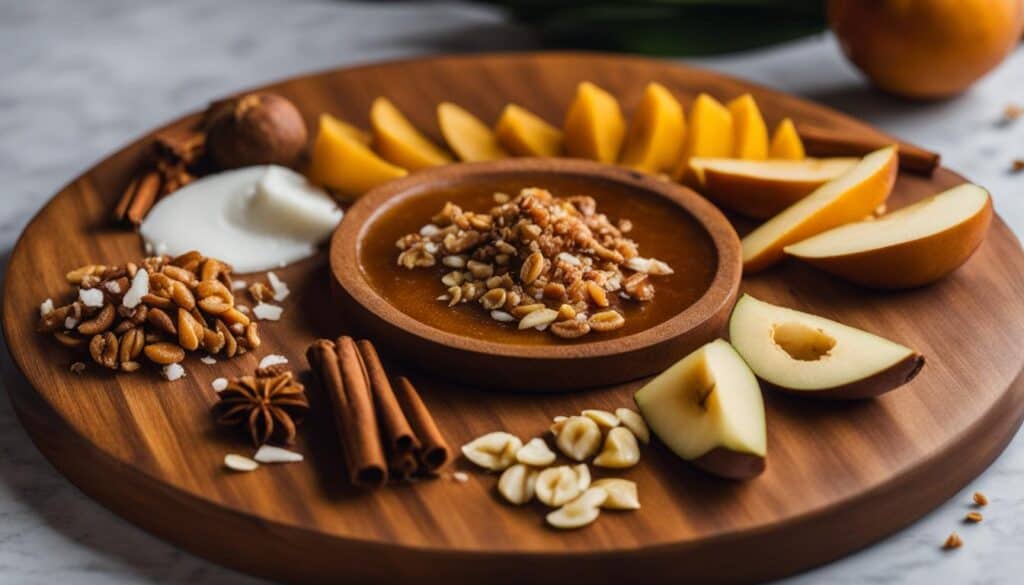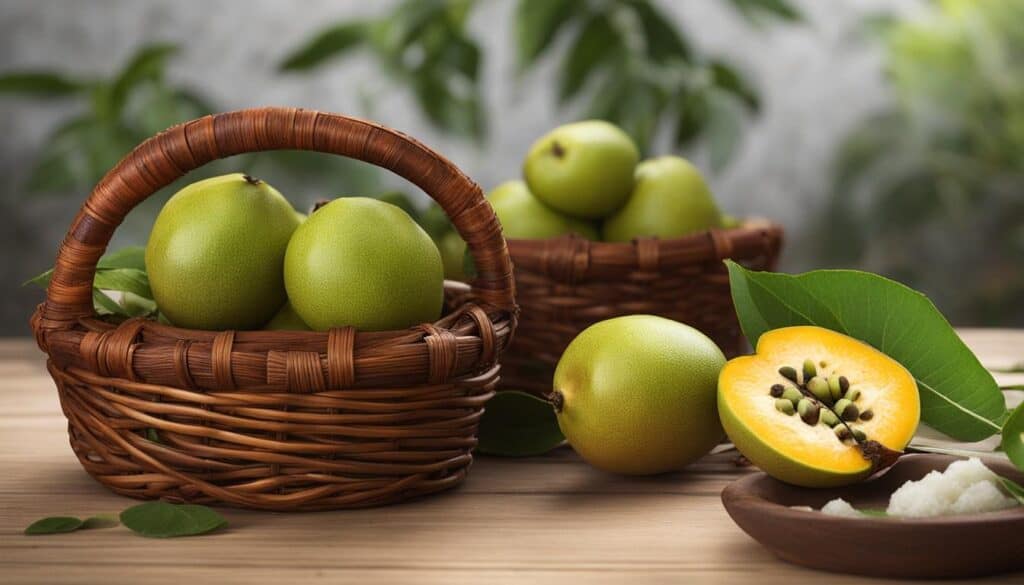Sapota, also known as sapodilla or chikoo, is a popular tropical fruit that is loved for its sweet flavor and numerous health benefits. This delicious fruit is native to Mexico, Central America, and the Caribbean and has made its way into various parts of the world, including India. In India, sapota is extensively cultivated in states like Karnataka, Maharashtra, and Gujarat.
It is known by different names in different languages, such as chikoo in Hindi, chikku in Marathi, and sapeta in Bengali. Sapota is a versatile fruit that can be enjoyed on its own or used in various recipes, and it offers a wide range of nutritional benefits.
Key Takeaways:
- Sapota, also known as sapodilla or chikoo, is a tropical fruit loved for its sweet flavor and health benefits.
- It is native to Mexico, Central America, and the Caribbean, and is cultivated in different parts of India.
- Sapota can be enjoyed on its own or used in various recipes.
- It offers a wide range of nutritional benefits and is packed with essential vitamins, minerals, and polyphenol compounds.
- Sapota has been used in traditional Ayurvedic medicine for its healing properties and is believed to balance doshas.
The Origins and Cultivation of Sapota
Sapota, or sapodilla, is a delicious tropical fruit that has a fascinating history and is cultivated in various parts of the world. Let’s delve into the origins and cultivation of this beloved fruit.
Sapota has its roots in Mexico, Easter Guatemala, and Central America. It was later introduced to the Philippines before making its way to India in the late 19th century. Today, India is one of the largest producers of sapota, with states like Karnataka, Maharashtra, and Gujarat leading the cultivation efforts.
There are several varieties of sapota grown in India, each with its own unique characteristics and names. Some popular varieties include Kali Patli, cricket ball, and Baramati. The sapota tree is an evergreen, slow-growing tree that thrives in warm and moist climates. After three to four years of planting, the trees start bearing fruit, yielding twice a year.
Sapota Varieties Cultivated in India
| Variety | Characteristics |
|---|---|
| Kali Patli | Small to medium-sized fruit with dark brown skin and sweet flesh. |
| Cricket Ball | Large fruit resembling a cricket ball, with a reddish-brown skin and juicy, flavorful flesh. |
| Baramati | Medium-sized fruit with a round shape and yellowish-brown skin. It has a rich, sweet flavor. |
Sapota cultivation requires careful attention to temperature, moisture, and soil conditions. The trees thrive in well-drained soil and prefer temperatures between 20 to 38 degrees Celsius. Adequate irrigation and regular pruning are essential for optimal growth and fruit production.
Overall, the origins and cultivation of sapota showcase the fruit’s journey from its native lands to becoming a beloved tropical delight in different parts of the world, including India.
The Nutritional Value of Sapota
Sapota, also known as sapodilla or chikoo, is not only delicious but also packed with essential nutrients that promote overall health. This tropical fruit offers a range of vitamins, minerals, and fiber, making it a valuable addition to a balanced diet.
One of the key nutritional benefits of sapota is its high fiber content. Fiber plays a crucial role in supporting digestive health and promoting regular bowel movements. Additionally, sapota is rich in vitamins, including vitamin A, vitamin C, and B-complex vitamins like folate and B1. These vitamins contribute to various bodily functions, such as boosting immunity, supporting eye health, and aiding in energy production.
Sapota is also a good source of minerals like potassium, iron, and copper. Potassium is essential for maintaining healthy blood pressure levels, while iron supports red blood cell production and helps prevent anemia. Copper, on the other hand, is involved in the production of collagen, a protein that supports healthy skin and connective tissues.
| Nutrient | Amount per 100g |
|---|---|
| Calories | 83 |
| Dietary Fiber | 5.3g |
| Vitamin A | 43µg |
| Vitamin C | 14.7mg |
| Potassium | 193mg |
| Iron | 1.1mg |
| Copper | 0.4mg |
“Sapota is a nutrient-dense fruit that offers numerous health benefits. It is high in calories, providing 83 calories per 100 grams. The fruit is a rich source of dietary fiber, which aids in digestion and promotes bowel movement. It is also packed with essential vitamins and minerals, including vitamins A, C, folate, B1, B5, and minerals like potassium, iron, and copper. These nutrients support various bodily functions and contribute to overall well-being.”
In addition to its vitamins and minerals, sapota is known for its high content of polyphenol compounds, such as tannins. These polyphenols possess antioxidant, anti-inflammatory, antiviral, antibacterial, and anti-parasitic properties, making sapota beneficial for overall health and well-being.
Health Benefits of Sapota
Sapota, also known as sapodilla or chikoo, not only offers a delicious taste but also provides a range of health benefits. Let’s explore the various ways in which consuming sapota can contribute to your well-being:
- Boosts Energy: With its high calorie content and natural sugars, sapota is a great source of instant energy. It is an ideal snack option for athletes, fitness enthusiasts, or anyone needing a quick energy boost.
- Promotes Digestion: The fiber content in sapota aids in digestion and promotes bowel movement, preventing constipation. It also contains natural plant compounds that help regulate the digestive system and treat digestive problems.
- Strengthens the Immune System: Sapota is packed with vitamins, particularly vitamin C, which plays a crucial role in boosting immunity. Consuming sapota regularly can help strengthen your immune system, making you less susceptible to common illnesses.
- Fortifies Bones: Sapota contains essential minerals like potassium, calcium, and phosphorus, which are vital for bone health. Regular consumption of sapota can help strengthen bones, prevent osteoporosis, and promote overall bone health.
- Prevents Cancer: Sapota is rich in antioxidants, such as polyphenols and tannins, which have been found to have anti-cancer properties. These antioxidants help neutralize free radicals in the body, reducing the risk of cancer development.
- Treats Anemia: Sapota is a good source of iron, a mineral necessary for the production of red blood cells. Consuming sapota can help improve iron levels in the body, preventing or treating anemia.
- Regulates Blood Pressure: The potassium content in sapota helps regulate blood pressure levels and maintain a healthy cardiovascular system. It promotes proper blood flow, reduces stress on the blood vessels, and lowers the risk of hypertension.
- Improves Vision: Sapota is rich in vitamin A, which is essential for maintaining good vision. Regular consumption of sapota can help improve eyesight, prevent night blindness, and promote overall eye health.
- Anti-Inflammatory Properties: The antioxidants and anti-inflammatory compounds present in sapota help reduce inflammation in the body, alleviating symptoms of inflammatory conditions such as arthritis and joint pain.
These are just a few of the many health benefits that sapota offers. Whether you enjoy it as a standalone fruit or include it in various recipes, sapota is a nutritious addition to your diet that can contribute to your overall well-being.

Sapota in Ayurveda
Sapota, also known as sapodilla, has been used in traditional Ayurvedic medicine for centuries due to its numerous medicinal properties. Ayurveda, the ancient Indian system of medicine, recognizes the healing potential of sapota and its various parts, including the fruit, seeds, and leaves.
The Medicinal Properties of Sapota
Sapota possesses several medicinal properties that make it a valuable ingredient in Ayurvedic remedies. The fruit is rich in antioxidants, which help neutralize free radicals and protect the body against oxidative stress. It also has antimicrobial properties, making it beneficial for treating various skin and hair issues.
“Sapota is believed to balance vata and pitta doshas and increase kapha dosha.”
Uses of Sapota in Ayurveda
In Ayurveda, sapota is used to balance vata and pitta doshas and increase kapha dosha. It is believed to have a cooling effect on the body and is often used to treat gastritis and other stomach ailments. The leaves of the sapota plant have been found to be effective in healing mouth ulcers, while the seeds are used as a natural remedy for dandruff and scalp issues.
Overall, sapota holds a significant place in Ayurvedic medicine and is valued for its therapeutic properties. Its versatility and effectiveness in treating various ailments make it a valuable addition to Ayurvedic remedies and practices.
| Ayurvedic Uses of Sapota | Medicinal Properties |
|---|---|
| Balance vata and pitta doshas | Antioxidant |
| Increase kapha dosha | Antimicrobial |
| Treat gastritis and stomach ailments | |
| Heal mouth ulcers |
Culinary Uses of Sapota
Sapota, also known as sapodilla or chikoo, is a versatile fruit that can be enjoyed in various culinary preparations. Its deliciously sweet flavor and creamy texture make it a popular ingredient in a wide range of recipes. Whether you prefer it as a standalone fruit or as an addition to your favorite dishes, sapota is sure to tantalize your taste buds.

One of the simplest ways to enjoy sapota is by eating it fresh, on its own. Simply cut the fruit in half and scoop out the luscious flesh. Its natural sweetness makes it a delicious and healthy snack.
Sapota can also be used in a variety of desserts. It adds a unique flavor and creamy texture to dishes like halwa and kheer. You can also incorporate sapota into ice creams, jams, jellies, and cakes for a delightful twist. The possibilities are endless when it comes to creating sweet treats with sapota.
For those who enjoy smoothies and milkshakes, sapota is a fantastic addition. Its sweet and slightly caramel-like flavor pairs well with other fruits, creating a refreshing and satisfying beverage. Blend sapota with fruits like mango, banana, or strawberry for a creamy and flavorful smoothie.
Table: Culinary Uses of Sapota
| Recipe | Description |
|---|---|
| Fresh Sapota Salad | A simple and refreshing salad made with fresh sapota, mixed greens, and a light citrus dressing. |
| Sapota Halwa | A traditional Indian dessert made with sapota puree, ghee, sugar, and a hint of cardamom. It is rich, decadent, and full of flavor. |
| Sapota Smoothie | A creamy and delicious smoothie made with sapota, banana, almond milk, and a touch of honey. It is a perfect way to start your day or enjoy as an afternoon pick-me-up. |
| Sapota Ice Cream | A homemade ice cream recipe that combines the sweetness of sapota with the creamy richness of milk and cream. It is a delightful frozen treat for any time of the year. |
Experiment with sapota in your favorite recipes and discover the delightful flavors it adds. From salads to desserts, sapota is a versatile fruit that can elevate any dish. So, unleash your culinary creativity and enjoy the delicious world of sapota!
Selecting and Storing Sapota
Choosing the right sapota is essential to ensure you enjoy its delicious flavors and nutrients. When selecting sapota, look for fruits with smooth, intact skin and no cuts or wrinkles. The skin should be firm and free from blemishes. Ripe sapota will yield to gentle thumb pressure, indicating that it is ready to be enjoyed.
Once you have selected your sapota, it is important to store it properly to maintain its freshness. Unripe sapota can be stored at room temperature for about 7 to 10 days until it ripens. Place the fruit in a cool and dry place away from direct sunlight. Once the sapota is ripe, you can store it in the refrigerator to extend its shelf life. Keep it in a perforated plastic bag or airtight container to prevent it from drying out.
Before consuming sapota, it is recommended to wash the fruit thoroughly to remove any sandy residues. To serve, cut the fruit into halves and scoop out the flesh. Remember to remove any seeds before consuming or using sapota in recipes, as the seeds are not edible.
| Selection Tips | Storage Tips |
|---|---|
| Choose fruits with smooth, intact skin | Store unripe sapota at room temperature |
| Look for firm skin without cuts or wrinkles | Keep ripe sapota in the refrigerator |
| Ensure the fruit yields to gentle thumb pressure when ripe | Store in a perforated plastic bag or airtight container |
| Wash the fruit before consuming or using in recipes |

Tips for Using Sapota in Recipes
Sapota, also known as sapodilla or chikoo, is a versatile fruit that can be used in various recipes to add a touch of sweetness and unique flavor. Whether you’re a seasoned chef or an amateur cook, here are some tips to help you make the most of sapota in your culinary creations:
- Choose ripe and flavorful sapota: When selecting sapota for your recipes, opt for fruits that are fully ripe. Ripe sapotas are soft and yield to gentle pressure. They will have a sweet aroma and a deep orange color. This ensures that you get the best flavor and texture for your dishes.
- Pair sapota with complementary ingredients: Sapota’s creamy texture and sweet flavor make it a great addition to both sweet and savory dishes. You can combine sapota with other tropical fruits like mango, pineapple, or banana to create refreshing smoothies or fruit salads. For a savory twist, try adding sapota to salads or salsas for a unique flavor profile.
- Experiment with different cooking methods: Sapota can be enjoyed raw, but you can also incorporate it into cooked dishes for a delicious twist. Try grilling sapota slices to enhance their natural sweetness, or bake them into desserts like pies, tarts, or cakes for a rich and indulgent treat.
- Don’t forget about sapota puree: If you’re looking to add sapota flavor to your recipes without the texture, you can make a smooth puree by blending ripe sapota flesh in a food processor or blender. This puree can be used as a natural sweetener in baked goods, sauces, or even as a base for ice cream or sorbet.
So, whether you’re craving a refreshing smoothie, a tropical dessert, or a unique twist on a savory dish, don’t hesitate to experiment with sapota in your recipes. With its sweet flavor and creamy texture, sapota is sure to elevate your culinary creations to new heights.

| Sapota Side Effects | Sapota Precautions |
|---|---|
| 1. Mouth ulcers | 1. Consult with a healthcare professional before including sapota in your diet |
| 2. Throat irritation | 2. Avoid excessive consumption of unripe sapota fruits |
| 3. Breathing difficulty | 3. Listen to your body and consume sapota in moderation |
| 4. Incorporate sapota along with other fruits and vegetables for a balanced diet |
Conclusion
Sapota, or sapodilla, is a delicious tropical fruit that is loved for its sweet flavor and multitude of health benefits. Whether enjoyed on its own or used in various recipes, sapota offers a rich array of nutrients that support overall well-being.
One of the key benefits of sapota is its ability to aid digestion, thanks to its high fiber content and natural plant compounds. It also strengthens bones, promotes healthy skin, and boosts the immune system.
With its versatility and nutritional value, sapota is a fruit that can be easily incorporated into a balanced diet. So, don’t miss out on this tasty and nutritious fruit – start unlocking the delicious world of sapota in English today!
FAQ
What is sapota?
Sapota, also known as sapodilla or chikoo, is a tropical fruit loved for its sweet flavor and numerous health benefits.
Where does sapota come from?
Sapota is native to Mexico, Central America, and the Caribbean. It has also been cultivated in India since the late 19th century.
What are the health benefits of sapota?
Sapota is a nutrient-dense fruit that offers several health benefits, including aiding digestion, strengthening the immune system, fortifying bones, preventing cancer, and improving vision.
How can sapota be used in recipes?
Sapota can be enjoyed on its own or used in various recipes, such as smoothies, milkshakes, desserts like halwa and kheer, fruit salads, and even ice creams, jams, jellies, and cakes.
How should sapota be stored?
Ripe sapota should be stored in the refrigerator for a few days. Unripe sapota can be stored at room temperature for 7 to 10 days until it ripens.
Are there any side effects of consuming sapota?
Eating unripe sapota can cause mouth ulcers, throat irritation, and breathing difficulty, especially in children, due to the high content of latex and tannins. It is important to consume sapota in moderation and eat only ripe fruits.
Source Links
- https://netmeds.com/health-library/post/sapodilla-sapota-health-benefits-nutrition-uses-recipes-and-side-effects
- https://netmeds.com/health-library/post/sapota-chickoo-7-amazing-health-reasons-to-add-chikoo-in-your-diet
- https://timesofindia.com/life-style/food-news/everything-you-need-to-know-about-sapota-and-its-culinary-uses/photostory/84112275.cms





Leave a Reply